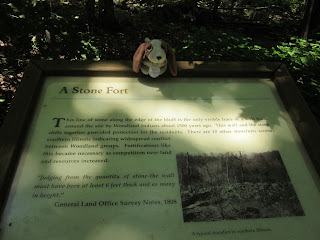Krista and Sir
Francis go to Millstone Bluff Archaeological Area
Latitude: 37º 27.995 N
Longitude: 88º 41.264
W
Total Miles: traveled 94.16 by car and 1 mile on foot
and paws
Krista
Brouwer and I, Sir Francis, went to Millstone Bluff Archaeological Area located
in the Shawnee National Forest in Robbs, Illinois on August 24, 2013. This is off the Vienna I-57 exit in Southern
Illinois and is located right on Route 147.
There is a visitor’s sign right at the entrance, so be sure to look for
this if you go and visit. We had a great
time (even though it has hot and buggy) as we learned information about the
Mississippian and Woodland Indians through the interpretive signs along the
trail. This historical site is protected
by the U.S. Department of Agriculture because of the rare artifacts that have been found
there. The reason it is called “Millstone
Bluff” is because that is what the local people, who settled here around
one-hundred years ago, called the area.
They came here and created large millstones using the surrounding
sandstone to grind their grain. I had
Krista take a picture of me sitting on top of the large stone circle that is a
millstone.
One of the first things we saw on the trail was
evidence of an old stone wall. So far,
archaeologists have discovered ten of these “stone forts” in the Southern
Illinois region, indicating that there were conflicts among the Woodland
Indians in the area. There are also
visible signs of a community burial area, which you can see here in the picture
that has the rectangular-stone outline coming up from the ground. Krista thought it was cool, but I thought it
was a bit spooky! Unfortunately, this
community cemetery has been raided by looters and those seeking to find Indian
artifacts. This is very inappropriate
behavior. How would you feel if someone
stole something from your loved one’s grave?
Petroglyphs
are carved into the rocks in a central location. Several of these stone-carved pictures are of
animals. Indians highly revered animals
as their equals and believed many of them to be spiritual. The picture with me and a stone with lines
carved in it is an actual carving of a Thunderbird. The Thunderbird is a legendary creature
embraced by many North American natives that is supposed to have magical
powers. Boys and girls, it is extremely
important that if you go to visit Millstone Bluff that you do not disturb these
rocks that have the petroglyph carvings or any other artifacts that are
there. You can do this by simply staying
of the trail.
Krista and
I continued up a small incline where we found evidence of the Indians’
individual homes and a community gathering area. You might wonder how historians know
this. Historians believe Mississippian
homes were built in a rectangular fashion; however, after hundreds of years of
decay, a circular-like divot was formed.
When archaeologists find several divots about the same size, in the same
area, this is a clue that they may have run across an old Indian Village. Because community gatherings were, and still
are, an important part of any culture, archaeologists many times find evidence of
large clearings with larger divots than that of individual homes. Many times there was a large clearing for
outdoor community gatherings and another large area for a community building
where special meetings could take place.
These community areas are usually
in a central location, with evidence of smaller ground impressions surrounding
it. Do you know of a building in your
community where people gather for meetings?
What kinds of decisions are made there?
Krista and
I ended our hike by reading the last interpretive sign that has a quote by
Abraham Lincoln. It reads, “A country
with no regards for its past has little to remember in its future.” What do you think this means and why would
historians feel that this is an important to quote to end the trail with? Krista and I talked about it, and we think it
means that the past, present, and future are all very closely linked. Learning about those in the past help all of us
make decisions about what we do today.
When today becomes the past tomorrow, what will we have learned that
helps us make better and smarter decisions to make the world a better place
tomorrow?







